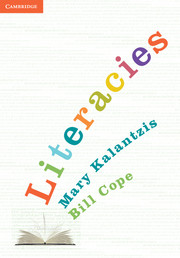Book contents
- Frontmatter
- Contents
- Acknowledgements
- Introduction The work of learning and teaching literacies
- Part A The ‘Why’ of Literacies
- Part B Approaches to Literacies
- Part C The ‘What’ of Literacies
- Chapter 7 Literacies as multimodal designs for meaning
- Chapter 8 Making written meanings
- Chapter 9 Making visual meanings
- Chapter 10 Making spatial, tactile and gestural meanings
- Chapter 11 Making audio and oral meanings
- Part D The ‘How’ of Literacies
- References
- Index
Chapter 9 - Making visual meanings
from Part C - The ‘What’ of Literacies
- Frontmatter
- Contents
- Acknowledgements
- Introduction The work of learning and teaching literacies
- Part A The ‘Why’ of Literacies
- Part B Approaches to Literacies
- Part C The ‘What’ of Literacies
- Chapter 7 Literacies as multimodal designs for meaning
- Chapter 8 Making written meanings
- Chapter 9 Making visual meanings
- Chapter 10 Making spatial, tactile and gestural meanings
- Chapter 11 Making audio and oral meanings
- Part D The ‘How’ of Literacies
- References
- Index
Summary
Overview
This chapter explores the ways in which we make visual meanings. We do this to construct a design analysis of the visual for the purposes of literacies learning and teaching. We will be referring to two types of visual meanings or images. Perceptual images are the things that you see with your body’s eye – your vision. Mental images are the things you see in your mind’s eye – your envisionings. This is because the world does not just present itself for us to simply see. Our minds make visual sense of the world through what we call perceptual imaging. We can also envision things that we cannot for the moment see by using our imaginations. Growingly aware babies make sense of the world first by seeing it and making mental images, only later learning words for what they see. Those without sight do the same thing through what they hear and feel. In fact, all humans work with mental images of the world, no matter what their physical capacities. In this chapter, we outline the similarities and differences between visual images and language. The similarities in these two symbolic ways of making meaning allow us to refer to the same things in language or in a visual image. Important differences, however, remain. Visual images and words can never be quite the same. This chapter also gives examples of classrooms in which teachers engage their learners in meaning-making texts that move between images and writing. These experiences highlight the power of synaesthesia, the process of shifting from one mode to another, and integrated, multimodal learning.
Visual representation and communication
Word and image: making the connections
Written meaning has been privileged over visual meaning for a long while. Writing has certainly been regarded as more powerful than image since the rise of print culture and mass-institutionalised schooling. This situation began to change in the twentieth century with the rise of new media including photography, lithographic printing, radio and television. In its own way, each of these media offered an alternative or supplement to writing as a way of recording meanings and communicating meanings across distances.
- Type
- Chapter
- Information
- Literacies , pp. 248 - 280Publisher: Cambridge University PressPrint publication year: 2012
- 1
- Cited by



